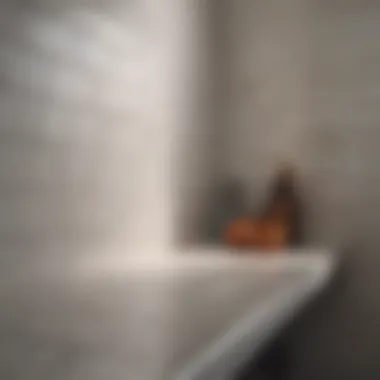Exploring Subway Tile Patterns for Kitchen Backsplashes


Intro
Subway tile patterns have transcended their modest origins to become a cornerstone of contemporary kitchen design. Their characteristic rectangular shape and glossy finish evoke a sense of simple elegance, making them a favorable choice for homeowners and interior design enthusiasts alike. This article aims to explore the aesthetic versatility and functional practicality of these tiles when used as kitchen backsplashes. It will provide insights into current design trends, color palettes, and the overall impact of subway tiles on kitchen spaces. Through thoughtful analysis, we seek to arm both novice decorators and seasoned professionals with the knowledge to make informed decisions in their tile selection and installation processes.
Design Inspiration
The selection of subway tiles can significantly influence the overall aesthetic of your kitchen. Modern designs often emphasize simplicity and clean lines. Here, we delve into various aspects that inform contemporary interiors.
Current Interior Design Trends
The fixation on minimalism in home decor has led to a renewed appreciation for classic materials. Subway tiles are often used in conjunction with open shelving, hardwood cabinets, and brass fixtures. This approach creates an environment that feels both inviting and sophisticated. The dimensionality of subway tiles also allows for creative arrangement options, such as herringbone and vertical stacking, that challenge conventional layouts.
"Design is not just what it looks like and feels like. Design is how it works." – Steve Jobs
Color Palettes and Their Effects
When considering color palettes, it's essential to recognize the psychological effects colors can have on a space. Subway tiles are available in a range of hues. Classic white and soft grey are popular for achieving a timeless look, while bold colors like navy blue or emerald green can add striking accents. Using a combination of colors can also create visual interest. It's advisable to think about the overall theme you want to achieve when selecting tiles:
- Neutral Shades: Promotes serenity and spaciousness.
- Bright Colors: Energizes the environment and can be used as focal points.
- Mixed Finishes: Glossy versus matte finishes can enhance the texture of the design.
The interplay of color and texture is a critical factor in achieving a cohesive look that complements other kitchen elements.
Ending
Prolusion to Subway Tiles
Subway tiles have become an essential element in kitchen design, capturing both function and style. They are often associated with a clean and modern aesthetic, making them a preferred choice for many homeowners and designers alike. The versatility of these tiles allows them to enhance both traditional and contemporary spaces.
The significance of the subway tile lies not only in its visual appeal but also in its practical applications. This section will explore the historical significance and defining characteristics of subway tiles.
Historical Significance
Subway tiles were first introduced in the late 19th century. They gained popularity because of their use in New York City subway stations. The original design was created to meet the demands of urban environments, providing a surface that was easy to clean and maintain. Over the years, subway tiles have transitioned from being strictly utilitarian to a design staple in homes across the world.
Their historical context enriches their appeal. Many people appreciate the nostalgia and heritage associated with these tiles. They signify a certain timelessness that can connect modern spaces with the past.
This historical background enhances their value in kitchen design, allowing homeowners to incorporate a piece of history into their cooking spaces. Knowing this story can elevate the choices one makes in designing a kitchen.
Defining Characteristics of Subway Tiles
Subway tiles are easily recognized by their rectangular shape, typically measuring 3 inches by 6 inches. Their glossy finish contributes to their ability to reflect light, making spaces seem larger and brighter. However, size and finish are not the only defining features. Subway tiles are also known for their durability, which makes them suitable for areas prone to moisture and heat, like kitchens.
The material variety is also significant. Subway tiles can be made from ceramic, porcelain, glass, or even natural stone. Each material imparts a different aesthetic and offers varying levels of maintenance and durability.
- Ceramic tiles are affordable and available in various colors.
- Porcelain tiles are denser and more resilient, suitable for high traffic areas.
- Glass tiles add a modern touch but require more upkeep.
- Natural stone tiles offer unique textures and patterns, appealing to upscale designs.
These characteristics make subway tiles not just functional, but also a flexible and stylish option for kitchen backsplashes. Each selection can dramatically impact the overall kitchen theme, from rustic to modern, further emphasizing the importance of thoughtful tile choices.
Popular Subway Tile Patterns
Subway tile patterns play a significant role in enhancing the visual appeal of kitchen backsplashes. They contribute character and dynamic aesthetics to spaces that are often considered utilitarian. The right pattern can make a strong design statement while maintaining functionality. By understanding various subway tile patterns, homeowners can more effectively select styles that resonate with their personal taste and complement their overall kitchen design.
Subway tiles offer flexibility. They come in different colors, finishes, and materials, allowing for numerous arrangements. Choosing the right pattern can influence the mood and perception of the space. For example, intricate layouts can create a focal point, while simpler patterns maintain a clean look. This article delves into five popular subway tile patterns, discussing their unique characteristics and practical considerations that are helpful for decision-making in kitchen renovation.
Straight Lay Pattern
The straight lay pattern remains one of the most common choices for subway tiles. This pattern aligns tiles in tidy rows, either horizontally or vertically. Straight lay is simple yet effective in creating a sleek, uninterrupted appearance.
Benefits of Straight Lay:
- Versatility: Works well with various design styles, from traditional to modern.
- Ease of Installation: Generally straightforward, making it suitable for DIY enthusiasts.
- Timeless Appeal: This classic arrangement never goes out of style.


However, the straight lay pattern can lack visual interest when used alone. To enhance its appeal, consider borders or mixtures of colors.
Herringbone Pattern
The herringbone pattern consists of rectangular tiles arranged in a zigzag fashion. This layout introduces movement and energy to the backsplash.
Benefits of Herringbone:
- Visual Interest: Creates a dynamic look that captures attention.
- Great for Larger Spaces: Often works well in expansive kitchens as it adds depth.
- Customizable: Can be done with various materials and colors for personalized designs.
One thing to consider is that installation can be more challenging, especially for those unfamiliar with tile work. Accurate measurement is essential to achieve the desired effect.
Chevron Pattern
Similar to herringbone, the chevron pattern also consists of V-shaped tiles. However, instead of a staggered layout, the tiles are arranged in a continuous zigzag pattern. This produces a bold, graphic look.
Benefits of Chevron:
- Modern Aesthetic: Offers contemporary flair that can elevate a kitchen.
- Strong Focal Point: Excellent for creating statement walls.
- Color and Texture Play: The opportunity for various tile colors and textures enhances dimension.
The chevron pattern requires careful alignment. If misaligned, it can disrupt the whole effect, so professional installation is often recommended.
Stacked Bond Pattern
The stacked bond pattern features tiles laid directly on top of one another, creating a grid-like formation. It is known for its simplicity and clean lines, making it a popular choice for minimalists.
Benefits of Stacked Bond:
- Simplicity: Offers a straightforward look that many find appealing.
- Easily Customizable: Different tile sizes can be mixed to create unique designs.
- Budget-Friendly: Typically requires less tile than more complicated patterns.
While this pattern may lack some intricacies, it is well-suited for those who prefer understated elegance.
Diagonal Pattern
In a diagonal pattern, tiles are placed at a 45-degree angle. This layout can give the illusion of a more expansive space and a lively atmosphere.
Benefits of Diagonal:
- Depth Perception: Creates a larger feeling in smaller kitchens.
- Lively Design: Adds flair and movement to the overall design.
Installation can be tricky, as precise angles are necessary for a cohesive look. However, the result is a striking visual that reflects creativity and sophistication.
By exploring these popular subway tile patterns, homeowners can make informed decisions that enhance their kitchen's functionality and aesthetic value.
Material Choices for Subway Tiles
When it comes to selecting subway tiles for your kitchen backsplash, the choice of material is fundamental. The right material influences not only the aesthetics of your space but also its functionality and durability. Each type of material offers distinct characteristics, making it important to evaluate these options carefully. This section outlines the different materials commonly used for subway tiles, highlighting their benefits and considerations.
Ceramic Tiles
Ceramic tiles are one of the most prevalent choices for subway backsplashes. They are known for their affordability and versatility. Available in a range of colors, sizes, and finishes, ceramic tiles can complement any kitchen design.
- Durability: Ceramic tiles are generally resistant to chipping and scratching, which makes them suitable for high-traffic areas like kitchens.
- Ease of Cleaning: Their non-porous surface allows for easy cleaning with simple soap and water solutions.
- Variety: With numerous designs available, it is easy to find the perfect match for your overall kitchen decor.
However, homeowners should be wary of the potential for glazing defects, which can lead to discoloration over time. Always choose tiles from reputable manufacturers to ensure quality.
Porcelain Tiles
Porcelain tiles take the benefits of ceramic a step further. They are denser, more water-resistant, and often more durable than standard ceramic. This material is ideal for areas that may see moisture and heat, making it perfect for kitchens.
- Longevity: Porcelain tiles have superior resistance to wear and are less susceptible to staining.
- Color Consistency: They maintain their color better over time, even with exposure to sunlight.
- Design Options: Like ceramic, porcelain comes in many styles but can also mimic the appearance of natural stone or wood.
While they offer many advantages, porcelain tiles can be heavier and may require additional support during installation. Careful planning is necessary for a successful setup.


Glass Tiles
Glass tiles are increasingly popular for modern kitchen designs. Their sleek appearance adds sophistication and depth to any backsplash.
- Aesthetic Appeal: The reflective quality of glass tiles can enhance the natural light in a kitchen, creating a brighter atmosphere.
- Stain Resistance: Glass is inherently resistant to stains, making it an excellent choice for busy cooking environments.
- Ease of Maintenance: Cleaning is straightforward; typically, glass tiles only need glass cleaner or mild soap to maintain their shine.
On the downside, glass tiles can be more expensive than other options. Their installation also requires professional expertise due to their fragility and the need for precision.
Natural Stone Tiles
Natural stone tiles, such as marble, granite, and slate, bring an organic touch to kitchen backsplashes. Each piece is unique, offering a one-of-a-kind aesthetic.
- Distinctive Look: Natural stone provides a sophisticated ambiance and can significantly increase the value of your home.
- Longevity: Stone tiles are typically very durable and long-lasting.
- Heat Resistance: They can withstand high temperatures, which is a beneficial feature in cooking areas.
However, it's important to consider that natural stone often requires sealing to resist stains and moisture damage. They may also be more challenging to install and maintain.
"Choosing the right material for subway tiles not only beautifies your space but also impacts the utility and longevity of your kitchen backsplash."
In selecting materials for subway tiles, evaluate your design preferences alongside your practical needs. Understand the benefits and maintenance for each option to make an informed choice.
Choosing the Right Tile for Your Space
When it comes to kitchen design, the choice of tile can make or break the overall aesthetic of the space. Subway tiles, known for their versatile nature, require careful consideration. Choosing the right tile for your space involves evaluating various factors, such as size, layout, and color. Making an informed decision ensures that the final result enhances both the functionality and visual appeal of your kitchen backsplash.
Considerations for Size and Layout
The size of subway tiles directly influences the perception of space in your kitchen. Standard subway tiles typically measure 3 x 6 inches, but larger options like 4 x 12 inches and 6 x 18 inches are also available. Choosing the right size is crucial. Larger tiles can give a more modern look and reduce the number of grout lines, while smaller tiles can create a more traditional feel.
Layout is equally important. Different patterns, such as the classic offset pattern or a herringbone design, can drastically change the ambiance of a kitchen. A straight lay pattern offers simplicity, while a diagonal pattern can make a small space appear larger.
- Tip: Always view a sample layout on the wall before finalizing your choice.
- Remember: The right combination of size and layout can create a cohesive and inviting atmosphere.
Color Selection and Its Impact
Color plays a vital role in how subway tiles influence the mood of a kitchen. Lighter shades, like whites and soft pastels, can make a kitchen feel airy and open. Conversely, darker colors add depth and sophistication. Choosing the right color should also consider other kitchen elements, such as cabinets, countertops, and appliances.
Furthermore, the sheen of the tile affects how color is perceived. Matte finishes offer a rustic and understated feel, while glossy tiles can create a sleek, modern look. The ambiance shifts significantly based on these combinations.
"Choosing a color that complements existing kitchen features will ensure harmony in the design."
- Consideration: It may be beneficial to obtain samples and view them under different lighting conditions, as this can alter their final appearance.
- Tip: Think about your long-term style preferences. A timeless color will ensure that your kitchen remains relevant as design trends evolve.
Installation of Subway Tile Backsplashes
The installation of subway tile backsplashes is a vital component in transforming a kitchen. It requires careful planning, precise execution, and an understanding of various tools and materials. Proper installation enhances not only the aesthetic value but also the functionality of the backsplash. Homeowners often overlook this process, assuming it to be simple, but attention to detail is crucial for achieving a flawless look. Having the right techniques can make a significant difference in the outcome, ensuring that your kitchen appears professionally designed.
Tools Required for Installation
Before you begin the installation, it is essential to gather the necessary tools to ensure a smooth process. Here is a list of basic tools you will need:
- Tile cutter: A reliable tile cutter is critical for achieving precise cuts.
- Trowel: A notched trowel helps in spreading adhesive evenly.
- Level: Ensures that your tiles are installed straight and even.
- Grout float: Used for applying and spreading grout.
- Sponge: Essential for cleaning tiles during grouting.
- Measuring tape: Accurate measurements are key to proper tile layout.
- Caulking gun: Needed for applying caulk where the backsplash meets the countertop.
These tools facilitate a more manageable installation process, reducing the risk of errors.
Preparation of the Surface
Before laying your subway tiles, preparing the surface is of utmost importance. The walls where tiles will be applied must be clean, dry, and smooth. Begin by removing any previous finish, such as paint or wallpaper, as these can prevent proper adhesion. It’s often recommended to clean the surface with a suitable cleaner or degreaser, especially in a kitchen where grease can build up.
Next, assess whether the wall is flat. A level surface maintains a consistent appearance. If the wall is uneven, it might be necessary to patch holes or apply a layer of backer board to create a solid base. Ensure this base is securely fastened to the wall structure before proceeding.
Applying Adhesives and Grouts
Once the surface is prepared, the application of adhesive is the next step. Using a notched trowel, spread the adhesive across a manageable area of the wall. It’s advisable to work in small sections to prevent the adhesive from drying out before tiles are set. Press the tiles into the adhesive firmly, checking constantly with the level to maintain alignment. Spacing between tiles can be achieved with spacers, allowing room for grout in later stages.


After the tiles are set and adhesive has cured as per manufacturer instructions, the next step is to apply grout. Choose a grout that complements the color of your tiles. Use a grout float to push grout into the spaces between the tiles, ensuring all joints are filled.
"Taking your time during this stage will result in a more professional finish."
After the grout has set, clean the excess with a damp sponge. Wait for the recommended time before applying any sealer, ensuring your subway tile backsplash not only looks good but also stands the test of time.
Maintaining Subway Tile Backsplashes
Maintaining subway tile backsplashes is not just about keeping them looking fresh; it is critical for preserving their longevity and functionality. These tiles can be subjected to various forms of damage, such as stains, grime, and moisture. Proper maintenance ensures that they continue to be an attractive and hygienic element of your kitchen. Regular care will prevent minor issues from escalating into major problems, making your tiles last longer.
Cleaning Techniques for Different Materials
Different materials used for subway tiles require distinct cleaning methods. Understanding these methods can help you choose the best approach for your specific tiles.
- Ceramic Tiles: These are fairly easy to clean. Generally, a mixture of warm water and mild detergent is effective. For tougher stains, you can use a non-abrasive scrub pad. Avoid harsh chemicals as they can damage the glaze.
- Porcelain Tiles: Similar to ceramic, porcelain is quite durable. Use a soft microfiber cloth with warm water. If there are stains, a gentle cleaner can help. Do not use acidic cleaners that may harm the tile.
- Glass Tiles: Glass tiles can collect fingerprints and smudges. A glass cleaner or a vinegar-water solution can be used to maintain their shine. Always dry the surface to prevent water spots.
- Natural Stone Tiles: Stones like granite or marble require special attention. It's crucial to use a pH-neutral cleaner. Stone sealants can also protect against stains, but make sure to reapply them as per the manufacturer's recommendations.
Dealing with Common Issues
Over time, you may encounter several common issues with subway tile backsplashes. Knowing how to tackle these problems can save you from costly repairs.
- Grout Discoloration: Grout tends to absorb dirt and moisture, leading to discoloration. Regular sealing can prevent this. If discoloration occurs, a paste of baking soda and water can effectively clean it.
- Cracks or Chips: Small cracks can be a major concern. It is advisable to replace the affected tile. For chips, a color-matched epoxy can be used to fill them in, but it might not be a perfect match.
- Mold and Mildew: Kitchens are susceptible to rising humidity, which can lead to mold. It’s important to regularly inspect the grout lines for mold. A mixture of bleach and water can effectively treat mild cases, but always test a small area first.
"Prevention is key. Regular maintenance and timely attention to issues can keep your subway tiles looking new for years."
By understanding the proper cleaning techniques for different materials and addressing common issues proactively, you can ensure that your subway tile backsplashes remain a striking and functional element of your kitchen.
Trends in Subway Tile Design
The design of subway tiles has evolved beyond their classic origins in transportation infrastructure to become a staple in modern kitchen aesthetics. The relevance of trends in subway tile design lies not only in their visuals but also in their ability to adapt to changing tastes and technologies. As homeowners seek unique expressions of style in their kitchens, understanding these trends can be pivotal for making informed design choices that resonate with both current and future decor.
Contemporary Color Palettes
Modern subway tile designs feature a diverse array of color palettes. Traditional whites and creams, which have long dominated the market, are finding competition from bolder options such as deep blues, blacks, and even vibrant greens. This shift reflects a broader trend in home design, wherein colors are chosen not just for practicality but also for personality. A well-thought-out color adds emotional value and can transform the perception of space.
When selecting colors, consider the following:
- Complementary Tones: Pair subway tiles with cabinet colors for a cohesive look.
- Accent Colors: Use brighter tiles as accents rather than main colors to create focal points without overwhelming the design.
- Finish Variations: Glossy tiles catch light differently than matte finishes, affecting the overall look. Glossy tiles can add brightness, while matte finishes provide subtlety.
Ultimately, the choice of color should align with the kitchen’s overall theme and atmosphere, echoing the homeowner's unique taste.
Textured and Patterned Tiles
Textured and patterned subway tiles are gaining traction as a way to introduce depth and dynamism into kitchen spaces. Various textures can evoke different sensations; for instance, a rough, handmade finish can impart an organic feel, while sleek and smooth surfaces convey a modern aesthetic.
Patterns such as geometric arrangements and artistic motifs woerk well to break the monotony of traditional layouts. Like color choice, patterns allow for personal expression but require careful planning. Considerations include:
- Tile Size and Shape: Ensure the size and shape complement existing features in the kitchen.
- Harmonizing with Other Elements: Patterns should enhance rather than conflict with cabinetry, countertops, and appliances.
- Visual Balance: Achieving a balanced look often means limiting the use of patterned tiles in key areas while using solid colors elsewhere.
Textured and patterned tiles invite curiosity and interaction, making them a focal point in culinary environments while also providing practical benefits such as ease of maintenance and visual concealment of minor splatters or stains.
"Incorporating textures and patterns in subway design creates a unique visual story that adds dimension to your space.
Culmination
The conclusion of this article underscores the significance of subway tile patterns in kitchen backsplashes. Through various sections, we've explored the rich history, different patterns, and the evolving trends that make subway tiles a preferred choice for many homeowners and design enthusiasts. The aesthetic and practical benefits of these tiles elevate not only the kitchen but also the entire home environment.
Summarizing Key Points
In summary, key points to take away include the following:
- Historical Significance: Subway tiles originated in metropolitan transit systems, laying a foundation for their contemporary appeal.
- Varied Patterns: The variety of subway tile patterns, such as herringbone, stacked bond, or chevron, contribute distinct looks and feelings to a kitchen.
- Material Choices: Materials like ceramic, glass, and natural stone provide options that suit different styles and budgets.
- Installation and Maintenance: Understanding the installation process and maintenance requirements ensures longevity and endurance of the backsplash.
Final Thoughts on Subway Tiles
As you contemplate your kitchen design, consider subway tiles not just for their beauty but for their functionality as well. They are easy to clean, durable, and available in many colors and patterns that can fit any style. The recent trends also indicate a move toward personalized designs and unexpected combinations, allowing homeowners to express their creativity.
"Subway tiles offer an intersection of style and utility, serving as a canvas for personal expression in kitchen designs."
Embracing the potential of subway tiles can transform a simple kitchen into a sophisticated statement. The insights shared in this article will aid in making informed decisions, ensuring you choose wisely for your unique space.















